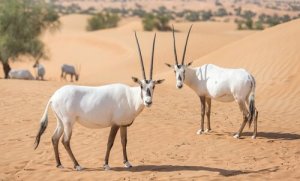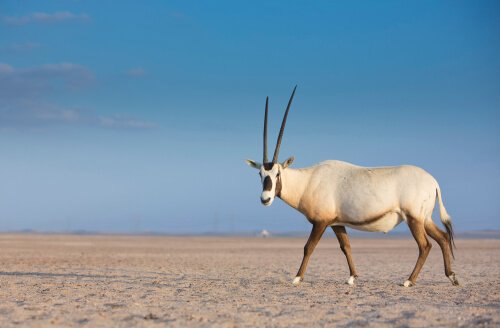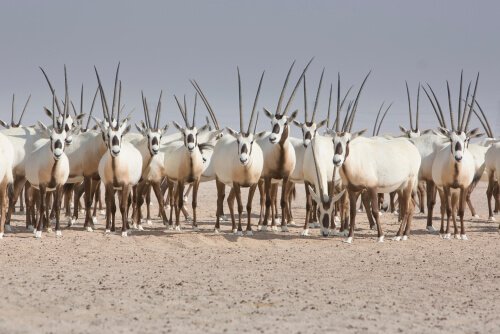Arabian Oryx: Reproduction and Conservation

The Arabian oryx is a bovine that, as per its name, populates the Arabian peninsula. It’s the most threatened species in the entire Artiodactyla order (hoofed animals). In this article, we’ll tell you what we know about it.
This animal is one of the mammals that’s better adapted to desert life, capable of surviving without water for several weeks. They obtain it by eating plants and they mainly eat at night, when the plants are moister after soaking up the nighttime humidity. Also, oryxes will dig for tubers and roots in order to obtain some liquids.
The Arabian oryx is approximately 3 feet high and weighs around 40 pounds and it stands out for its, mostly, white coat. Their legs are dark brown to black, their facial markings are black, and the tip of their tail and their lance-like horns are darker. (The white coat reflects the sunlight, while the dark legs help absorb the heat during cold desert mornings.)
Note that the horns are a feature of both genders in length and shape; they’re usually black. In addition, they’re about 3 feet long and are their best weapons for self-defense.
Arabian oryx: Reproduction and behavior
During the day, the Arabian oryx usually hides from the heat and rests until it’s night time which is when it begins to move around in order to perform its daily routine. It’s has a talent for detecting rain and can easily move towards it and find it. Its habitat extends to about 1300 square miles.
As we mentioned above, these ruminants can do without water for several weeks, just like dromedaries and other desert animals. When they’re not roaming around looking for food, the Arabian oryx dig shallow holes in the soft ground or under small bushes. They mainly feed on fruits, tubers, roots, herbs, bulbs, and buds.
The herds are mixed and made up of about 2 to 15 oryxes. They’re mostly peaceful, even solitary males, and can cohabit without problems. Of course, the breeding season is the exception; it usually takes place between May and December.

The gestation period for female oryxes is 240 days long and produces one calf which breastfeeds for about two and a half months.
The myth of the unicorn
The Arabian oryx is the national animal of Oman, Jordan, Arab Emirates, Qatar, and Bahrain. There are several mistakes in regard to the name used for this species. For example, one of the words used for them translates as “unicorn.”
The translation of the Hebrew word re’em: into Greek as monokeros (one-horn) in the Septuagint. In Psalm 22:21, the word Karen appears in singular and it means horn. The Roman Catholic Vulgate and the Douay-Rheims Bible translated re’em as rhinoceros.
Furthermore, other translations are names for a wild bull, wild oxen, buffalo, or gaur. In the end, the Arabic translation alrim is the most correct one, and it literally means “white oryx.”
Also, the myth may be based on oryxes that lost one horn. Aristotle and Pliny the Elder stated that the oryx was a prototype for a unicorn. It’s true that, from certain perspectives, this animal appears to have only one horn.
Also, because horns don’t grow back once they fall off, if one of these ruminants loses one for any reason, then it would have to live with just the one for the rest of its life.
In addition some people believe that the Arabian oryx horn has medicinal properties and it’s often used to treat all sorts of ailments.
Arabian oryx: Habitat and conservation
The Arabian oryxes prefer the desert areas with hard sand and gravel because they’re highly resistant to inclement weather. There they can protect themselves from their only natural predator: the wolf.
Historically, this real-life unicorn lived in most of the Middle East and until the early nineteenth century, there were large herds in Palestine, Sinai, Iraq, and Transjordan. Currently, the surviving herds mainly inhabit Saudi Arabia.

Due to progress, hunting, and other human intervention, the population of Arabian oryx drastically reduced during the past century. In the 1970s, there were no wild specimens left.
However, thanks to the efforts of some groups of ecologists and scientists, the Arabian oryx has now been reintroduced in Oman, Israel, the United Arab Emirates, Syria, Jordan, Qatar, and Bahrain. Currently, there are more than 1000 specimens enjoying their natural habitat, hence their addition to The IUCN Red List of Threatened Species.
The fact that the species has been reintroduced doesn’t necessarily mean the threat is gone. Indeed, the path to the conservation of species is quite arduous and slow. However, the reinsertion was definitely more successful than expected and the population of this animal, so characteristic of the desert, improves daily.
The Arabian oryx is a bovine that, as per its name, populates the Arabian peninsula. It’s the most threatened species in the entire Artiodactyla order (hoofed animals). In this article, we’ll tell you what we know about it.
This animal is one of the mammals that’s better adapted to desert life, capable of surviving without water for several weeks. They obtain it by eating plants and they mainly eat at night, when the plants are moister after soaking up the nighttime humidity. Also, oryxes will dig for tubers and roots in order to obtain some liquids.
The Arabian oryx is approximately 3 feet high and weighs around 40 pounds and it stands out for its, mostly, white coat. Their legs are dark brown to black, their facial markings are black, and the tip of their tail and their lance-like horns are darker. (The white coat reflects the sunlight, while the dark legs help absorb the heat during cold desert mornings.)
Note that the horns are a feature of both genders in length and shape; they’re usually black. In addition, they’re about 3 feet long and are their best weapons for self-defense.
Arabian oryx: Reproduction and behavior
During the day, the Arabian oryx usually hides from the heat and rests until it’s night time which is when it begins to move around in order to perform its daily routine. It’s has a talent for detecting rain and can easily move towards it and find it. Its habitat extends to about 1300 square miles.
As we mentioned above, these ruminants can do without water for several weeks, just like dromedaries and other desert animals. When they’re not roaming around looking for food, the Arabian oryx dig shallow holes in the soft ground or under small bushes. They mainly feed on fruits, tubers, roots, herbs, bulbs, and buds.
The herds are mixed and made up of about 2 to 15 oryxes. They’re mostly peaceful, even solitary males, and can cohabit without problems. Of course, the breeding season is the exception; it usually takes place between May and December.

The gestation period for female oryxes is 240 days long and produces one calf which breastfeeds for about two and a half months.
The myth of the unicorn
The Arabian oryx is the national animal of Oman, Jordan, Arab Emirates, Qatar, and Bahrain. There are several mistakes in regard to the name used for this species. For example, one of the words used for them translates as “unicorn.”
The translation of the Hebrew word re’em: into Greek as monokeros (one-horn) in the Septuagint. In Psalm 22:21, the word Karen appears in singular and it means horn. The Roman Catholic Vulgate and the Douay-Rheims Bible translated re’em as rhinoceros.
Furthermore, other translations are names for a wild bull, wild oxen, buffalo, or gaur. In the end, the Arabic translation alrim is the most correct one, and it literally means “white oryx.”
Also, the myth may be based on oryxes that lost one horn. Aristotle and Pliny the Elder stated that the oryx was a prototype for a unicorn. It’s true that, from certain perspectives, this animal appears to have only one horn.
Also, because horns don’t grow back once they fall off, if one of these ruminants loses one for any reason, then it would have to live with just the one for the rest of its life.
In addition some people believe that the Arabian oryx horn has medicinal properties and it’s often used to treat all sorts of ailments.
Arabian oryx: Habitat and conservation
The Arabian oryxes prefer the desert areas with hard sand and gravel because they’re highly resistant to inclement weather. There they can protect themselves from their only natural predator: the wolf.
Historically, this real-life unicorn lived in most of the Middle East and until the early nineteenth century, there were large herds in Palestine, Sinai, Iraq, and Transjordan. Currently, the surviving herds mainly inhabit Saudi Arabia.

Due to progress, hunting, and other human intervention, the population of Arabian oryx drastically reduced during the past century. In the 1970s, there were no wild specimens left.
However, thanks to the efforts of some groups of ecologists and scientists, the Arabian oryx has now been reintroduced in Oman, Israel, the United Arab Emirates, Syria, Jordan, Qatar, and Bahrain. Currently, there are more than 1000 specimens enjoying their natural habitat, hence their addition to The IUCN Red List of Threatened Species.
The fact that the species has been reintroduced doesn’t necessarily mean the threat is gone. Indeed, the path to the conservation of species is quite arduous and slow. However, the reinsertion was definitely more successful than expected and the population of this animal, so characteristic of the desert, improves daily.
All cited sources were thoroughly reviewed by our team to ensure their quality, reliability, currency, and validity. The bibliography of this article was considered reliable and of academic or scientific accuracy.
- Spalton, J. A., Lawrence, M. W., & Brend, S. A. (1999). Arabian oryx reintroduction in Oman: Successes and setbacks. ORYX. https://doi.org/10.1046/j.1365-3008.1999.00062.x
This text is provided for informational purposes only and does not replace consultation with a professional. If in doubt, consult your specialist.








